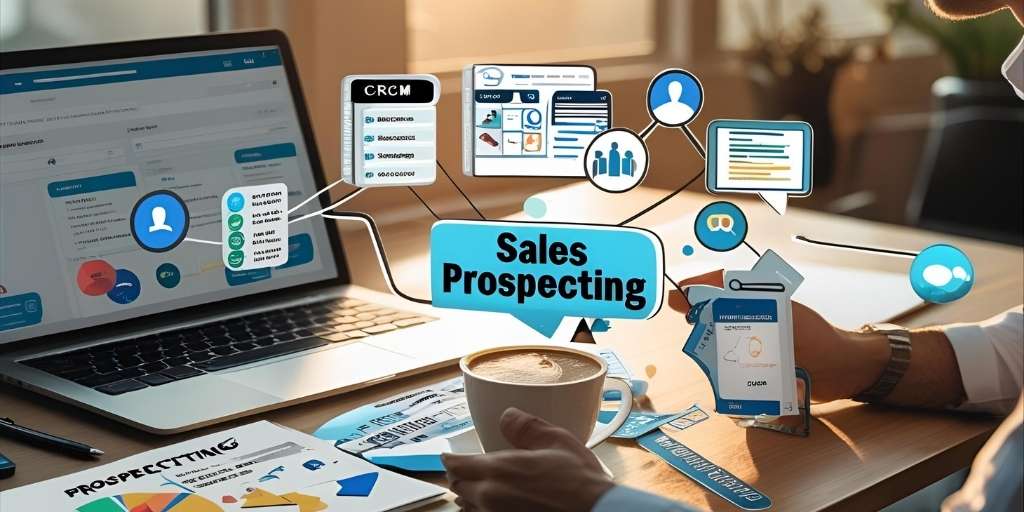In the current competitive business environment, the efforts of getting and relating to likely customers have become harder. Otherwise put, the sales departments in various sectors are in a continual quest to find something new to help them optimize their lead generation strategies and convert them into sales more effectively. That is where Sales Prospecting Tools come into play, as a revolutionary solution to the way that the business can integrate the process of acquiring customers.
Sales Prospecting Tools have become very sophisticated beyond mere contact databases and are applying artificial intelligence, machine learning, and big data analytics. These sophisticated solutions allow us to gain profound insights into the behavior, preferences, and purchase signals of prospects, which is why sales teams can create unique methods to appeal to their target audience.
What are Sales Prospecting Tools?
Prospecting Sales Tools is a type of specialized software used in sales to assist the salesperson in identifying, researching, and reaching out to potential buyers in a faster manner. These online tools are mass databases with all the necessary information about companies, decision-makers, contact data, and behavioral data that allows for buying an outreach campaign.
Fundamentally, these sites collect tons of business information across the web, such as in public records, social sites, corporate websites, and trade databases. Powerful algorithms exercise this data to generate a comprehensive profile of prospects, with contact details, company structures, latest updates, investment endeavors, and the use of technology.
Modern Sales Prospecting Tools are not just about contact management, but also capable of making work predictions and intent data, as well as tracking engagement. They assist sales departments in knowing where the prospect is in their buyer knowledge journey, what they find interesting by reading what they read, and what would be the best time to conduct a sales outreach exercise. Automation features are also common with many platforms that help automate repetitive actions like emailing in series, engagement with social media, and follow-up arrangements.
Comparison Table for Sales Prospecting Tools
| Tool | Rating | Website | Key Differentiator |
| Dealfront | 4.5/5 | dealfront.com | Largest compliant B2B database with 56M+ companies |
| LinkedIn Sales Navigator | 4.3/5 | linkedin.com | Native access to 1B+ professional network |
| ZoomInfo | 4.4/5 | zoominfo.com | Multi-channel engagement with global direct numbers |
| Apollo.io | 4.2/5 | apollo.io | Living Data Network with contributor insights |
| Cognism | 4.1/5 | cognism.com | Diamond-verified data through human verification |
| SmartReach.io | 4.6/5 | SmartReach.io | Built-in unlimited email validation system |
| 6Sense | 4.0/5 | 6sense.com | AI-driven Dark Funnel optimization |
| Lusha | 3.9/5 | lusha.com | Focus on the US and European markets |
| RocketReach | 3.8/5 | rocketreach.com | Social account matching capabilities |
| UpLead | 3.7/5 | uplead.com | Real-time email verification system |
| Seamless.ai | 3.6/5 | seamless.ai | Real-time web data retrieval |
Top 11 Sales Prospecting Tools
1. Dealfront
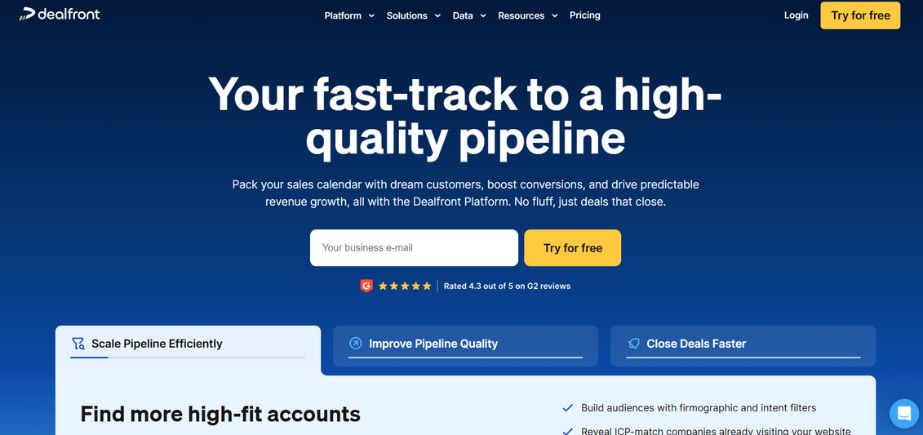
Type: Comprehensive Sales Intelligence Platform
Rating: 4.5/5
Website: dealfront.com
The Dealfront is the fruitful union of Finnish and German data expertise that has resulted in the generation of the most intense business intelligence platform in Europe. This platform serves more than 30,000 global clients, where the powers of Leadfeeder, which identifies the visitors to websites, are combined with the capabilities of Echobot to market the data.
The platform also outperforms most of the competitors in terms of compliant business information, with great coverage worldwide as well as high European-qualified information on data protection. Using sophisticated machine learning algorithms, Dealfront can convert raw data into practical sales knowledge, so that teams can find high-potential prospects and optimize their prospecting efforts so that they are more effective.
Key Features:
- 100+ search filters
- 56M+ company database
- 5,000+ tool integrations
- 30+ trigger alerts
- ML-powered lead scoring
Pros:
- Largest complaint database
- Extensive integration options
- Advanced filtering capabilities
Cons:
- Complex interface initially
- Premium pricing tiers
- European data focus
Pricing: Custom enterprise pricing starting from €99/month per user
2. LinkedIn Sales Navigator
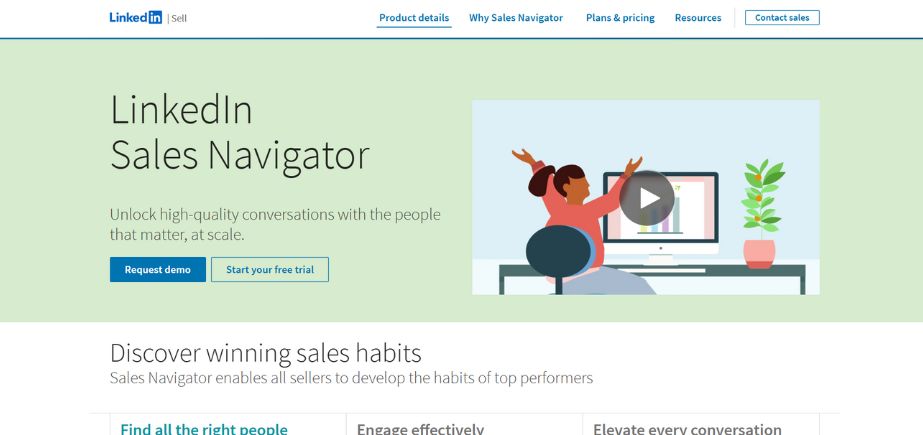
Type: Social Selling Platform
Rating: 4.3/5
Website: linkedin.com
The LinkedIn Sales Navigator is powered by the largest professional network in the world to help you get unmatched access to business decision-makers within various industries. The platform has more than a billion users around the world, providing distinct information about professional relations, career shifts, and industry networks that cannot be found in a traditional database.
The tool is also quite effective in relationship mapping and thus can enable sales professionals to find warm introductions, making use of common connections to achieve increased response rates. Complex search functions provide an opportunity to target specifically according to professional filters, and real-time notifications inform a user about the available actions related to prospects and interactions.
Key Features:
- 1B+ member access
- Relationship explorer mapping
- Smart content linking
- Real-time personnel alerts
- Advanced search filters
Pros:
- Massive professional network
- Relationship mapping features
- Real-time activity updates
Cons:
- Limited InMail credits
- Social platform dependency
- Higher premium costs
Pricing: Core ($79.99/month), Advanced ($134.99/month), Advanced Plus (Custom)
3. ZoomInfo
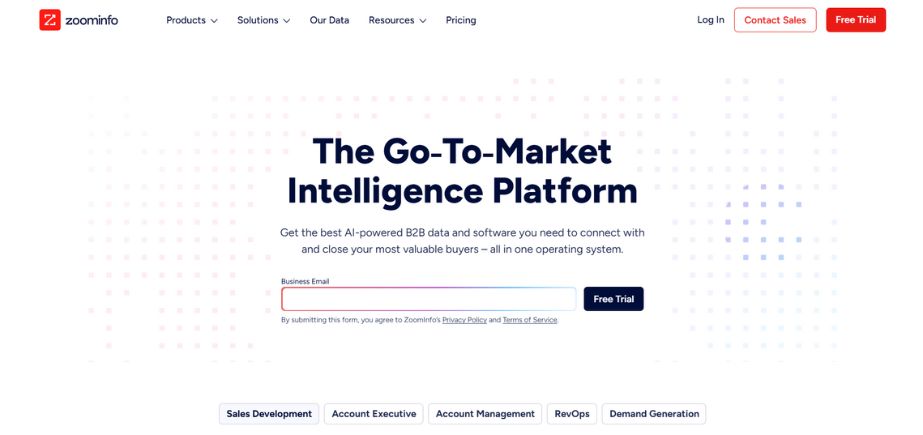
Type: Multifaceted Business Data Platform
Rating: 4.4/5
Website: zoominfo.com
ZoomInfo has developed as a fully integrated business intelligence platform, which has gone beyond classic prospecting into sales automation, online advertising, and recruiting. The main advantage of the platform is that it offers direct dialing numbers and valid contact data of decision-makers across the globe.
The Engage platform has enabled ZoomInfo to transform multi-channel prospecting by applying automated Salesflows that include email, phone, and social outreach in response to a given trigger in the market. Information on key business information. The company insights dashboard also has detailed organizational charts, allowing sales teams to know the internal organizational structures to find out the key contacts in target accounts with the greatest leverage.
Key Features:
- Global direct numbers
- Multi-channel Salesflows automation
- Organizational chart insights
- Email engagement analytics
- Advanced filtering engine
Pros:
- Comprehensive contact data
- Multi-channel automation
- Detailed company insights
Cons:
- Complex user interface
- Steep learning curve
- Higher price point
Pricing: Professional ($14,995/year), Advanced ($24,995/year), Elite (Custom)
4. Apollo.io
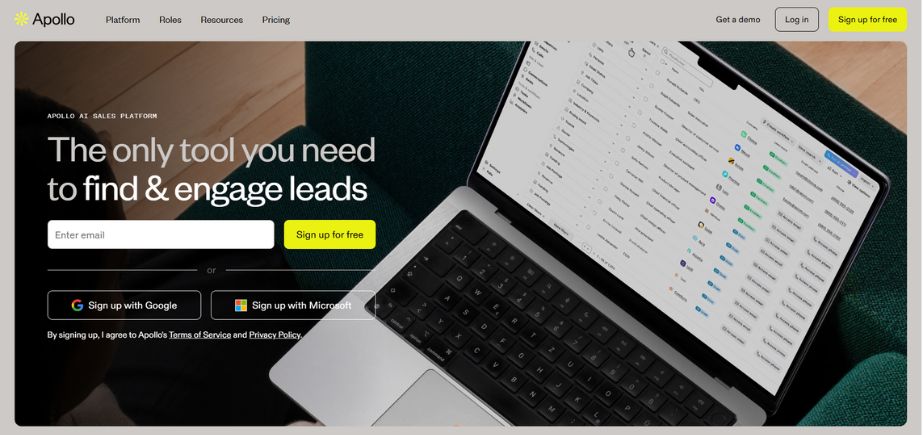
Type: Sales Intelligence and Engagement Platform
Rating: 4.2/5
Website: apollo.io
Apollo.io has gained a unique position in that it describes itself as having a Living Data Network algorithm, which ensures that any information added to the database by users is fresh and true. The platform integrates sales engagement together with prospecting abilities, enabling customers to make calls, send emails as well and communicate through social networks straight out of a single dashboard.
A seven-step email verification method used by Apollo also guarantees the rate of deliverability, and AI-texted messaging opens possibilities to personalize outreach on a larger scale. The main strength of the platform is the opportunity to filter prospects on the signals of buyer intent, job opportunities, and indicators of headcount growth.
Key Features:
- Living Data Network
- Seven-step email verification
- Integrated engagement tools
- AI-driven messaging
- Custom analytics dashboards
Pros:
- Unified engagement platform
- High email accuracy
- AI-powered personalization
Cons:
- Limited integration options
- Smaller database size
- Basic reporting features
Pricing: Free plan available, Basic ($39/month), Professional ($79/month), Organization ($119/month)
5. Cognism
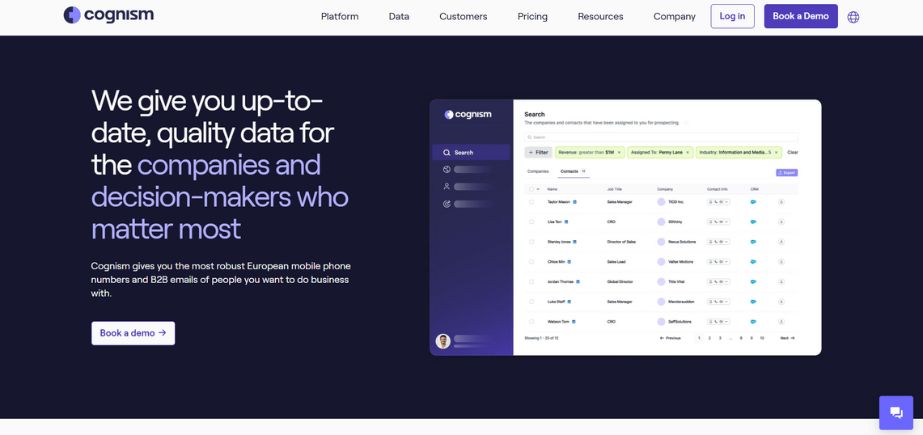
Type: Revenue Intelligence Platform
Rating: 4.1/5
Website: cognism.com
The unique feature by means of which Cognism positions itself against other providers is the Diamond-verified data model, which implies phone numbers are called by human verification teams to ensure their correctness and active state. Such a careful process of verification saves a lot of time on obsolete contact information.
The platform has a full coverage of EMEA, NAM, and APAC, mobile numbers, whereby related do-not-call lists of various countries are cross-verified. Cognism allows having an Intent Data feature, which helps to understand which accounts are actively searching for particular types of solutions to prioritize the prospects with the best chances of conversion and time the outreach to make it more effective.
Key Features:
- Diamond-verified contact data
- Intent data tracking
- Multi-region coverage
- Do-not-call compliance
- AI-human verification hybrid
Pros:
- Human-verified accuracy
- Strong compliance features
- Intent data insights
Cons:
- Limited bulk exports
- Regional coverage gaps
- Higher verification costs
Pricing: Starter ($89/month), Scale ($179/month), Accelerate ($269/month), Enterprise (Custom)
6. SmartReach.io
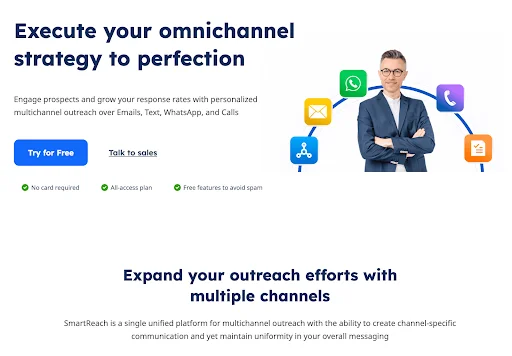
- Type: Sales Engagement Platform
- Rating: 4.6/5
- Website: smartreach.io
SmartReach.io is an AI-powered sales engagement platform designed to streamline outbound prospecting with automation and personalization at scale.
It helps sales reps engage with prospects through multi-channel outreach email, LinkedIn, WhatsApp, and calls ensuring higher response rates without sacrificing authenticity.
The platform provides best-in class email deliverability with features like email warm-up, spam detection, and inbox rotation that ensures your emails consistently land in the primary inbox.
With advanced analytics and team performance dashboards, sales managers get clear visibility into what’s working and what needs improvement.
Whether for startups or enterprise teams, SmartReach.io equips outbound sales reps with the right tools to build predictable sales pipelines.
Key Features:
- Multichannel outreach using channels like Email, LinkedIn, WhatsApp, Text and Phone Calls
- Built-in unlimited email validation system
- Built-in B2B lead database of 250Million US contacts
- AI email content writer
- Pre-configured domains and mailboxes for email infrastructure set-up
Pros:
- Unlimited email account addition at no extra charge
- Unlimited email blacklist checks
- Dedicated agency support
- No credit card required for the sign-up
Cons:
- UI may feel complex at the beginning
Pricing: Basic ($39/month), Plus ($99/month), Pro ($249/month), Enterprise (Custom) & Agency (custom). Also, they offer a 14-day free trial.
7. 6Sense
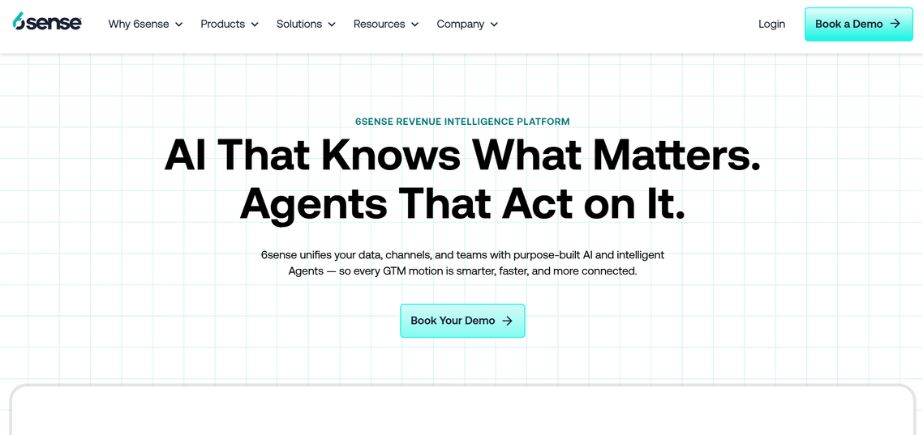
Type: AI-Driven Revenue Platform
Rating: 4.0/5
Website: 6sense.com
6Sense was the first to introduce Dark Funnel optimization, which concentrates on pinpointing and evaluating the anonymous buyer research activities on digital channels. Intent signals used by the platform include social networks, review sites, influencer blogs, and industry publications, which are used to foresee when the prospects are seeking solutions.
Enhanced predictive analytics encourage maximum opportunities at the ideal time, whereas a complete buyer journey mapping feature will give you the perception of how the prospect behaves, and that will encourage the sales and the marketer’s teams to liaise together in terms of the real-time buying signals and the engagement details.
Key Features:
- Dark Funnel analytics
- Predictive engagement timing
- Intent keyword searching
- Multi-source data collection
- Account-based coordination
Pros:
- Advanced predictive analytics
- Comprehensive intent data
- Account-based integration
Cons:
- Complex interface design
- Substantial training requirements
- High implementation costs
Pricing: Custom enterprise pricing (typically $30,000+ annually)
8. Lusha
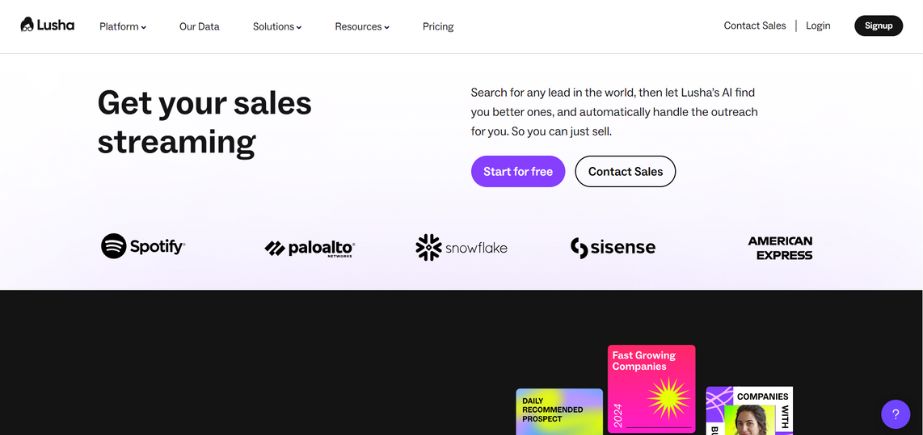
Type: Contact Intelligence Platform
Rating: 3.9/5
Website: lusha.com
Lusha concentrates more on the US and European markets and offers more thorough contact data that is customized by geography, position, and company hierarchy. It has a free trial version to enable users to test the platform first on the most entry-level functionality before having to pay to access higher-level features. The proprietary algorithm that Lusha filters through combines various data sources to generate a detailed profile of contacts, and weekly data updates keep the information up-to-date.
The API of the platform enables custom integrations, and as such, the platform is appropriate in organizations with special technical needs. Compared to other funding solution products, the more premium tiers provide features such as funding data searches that are accessible to sales teams that aim to target startups and growth companies.
Key Features:
- Geographic contact organization
- Weekly data refreshes
- Proprietary algorithm matching
- Custom API integration
- Funding data searches
Pros:
- Free version available
- Custom API access
- Regular data updates
Cons:
- Limited filter options
- Regional market focus
- Basic feature set
Pricing: Free plan, Pro ($39/month), Premium ($69/month), Scale ($99/month)
9. RocketReach

Type: Contact Discovery Platform
Rating: 3.8/5
Website: rocketreach.com
RocketReach is also a verified contact discovery platform, and it has one-of-a-kind social account matching alerts that combine prospect profiles across various platforms. The List Generation tool allows creating custom leads on the basis of advanced filtering parameters such as industry, revenue, number of employees, and educational level.
The platform possesses the power to allow an account holder to match their social profiles on different networks by uploading LinkedIn URLs, giving full intelligence of prospects. List-building tools built using artificial intelligence continuously improve match rates by selecting smart columns and executing intelligent data processing to scale the contact intelligence lifecycle of organizations.
Key Features:
- Social account matching
- Advanced filtering system
- Data enrichment API
- AI-powered list building
- Saved search functionality
Pros:
- Social profile unification
- Advanced filtering options
- API integration capabilities
Cons:
- Complicated pricing structure
- Limited intent data
- Tier-restricted features
Pricing: Starter ($39/month), Pro ($79/month), Ultimate ($199/month), Custom (Enterprise)
10. UpLead

Type: Global Lead Generation Platform
Rating: 3.7/5
Website: uplead.com
UpLead ensures that it covers a wide geographical range of data with precise data accuracy using real-time email verification tools, where the contact details are verified when a user accesses it. It is based on global data, and thus it is a great solution for sales teams that need to have international features of prospecting features. The technographic feature on UpLead makes it possible to target by the type of technology used, which enables sales to locate firms utilizing competitive or similar products.
The Intent Data aspect monitors general consumption trends and preferences in terms of engagement approaches so that sales representatives can better coordinate their efforts to approach their prospects at the most opportune time to increase conversion rates.
Key Features:
- Real-time email verification
- Global data coverage
- Technographics filtering
- Intent data tracking
- Real-time result updates
Pros:
- Global market coverage
- Real-time verification
- Technology-based targeting
Cons:
- Limited integration options
- Smaller feature set
- Basic automation tools
Pricing: Starter ($74/month), Professional ($149/month), Plus ($299/month)
11. Seamless.ai

Type: Real-Time Search Engine Platform
Rating: 3.6/5
Website: seamless.ai
Seamless.ai cannot be called ordinary as it provides the ability to get real-time search engine capabilities that access public web sources instead of having a stagnant database. Such an approach guarantees having the most recent information that can be found online, yet it is capable of causing a slower reaction rate.
Using technographics, the Pitch Intelligence tool offers in-depth information about a prospect’s technology stack, how they use it, and when they are ready to implement it. The district’s focus on CRM integration is especially prominent, which makes Seamless.ai especially appealing to teams that have previously invested in certain CRM systems, as pre-designed integration can be implemented with major systems.
Key Features:
- Real-time data retrieval
- Pitch Intelligence tool
- CRM integration focus
- Chrome extension addon
- Technology stack insights
Pros:
- Current data access
- Strong CRM integration
- Browser extension availability
Cons:
- Slower response times
- Limited database size
- Real-time dependency
Pricing: Free plan, Basic ($147/month), Pro ($297/month), Enterprise (Custom)
How to Choose the Right Sales Prospecting Tools
Choosing the right Sales Prospecting Tools involves a close assessment of the needs of your particular team, financial capacity, and integration needs. Take into consideration the database size, geographic coverage, verification procedure, and automatic capabilities.
- Budget: Find out how much you can spend on prospecting technology and estimate the returns that you should get on your investment. When weighing the different platforms and considering their payment models, put upfront costs as well as monthly and yearly subscription costs into consideration.
- Database size: Consider the size of a contact database that is included in each system and make sure that it fully covers your target markets. The prospect coverage is usually greater in large databases, which can at times be more expensive.
- Integration Powers: Gauge the compatibility of the future tools with your current CRM, marketing automation, and communication systems. Data upload without any breaks results in less manual data entry and less time consumption in the workflow.
- Verification Methods: You should think about precision and verification methods; every platform has to ensure quality in terms of data. Contacts that have been manually verified tend to be more expensive, but the success rate of outreach is better.
- Geographic Coverage: See whether the platform you are selecting will give enough coverage to your intended geographic markets, particularly when you are an international company or dealing with specific regional markets.
Benefits of Using Sales Prospecting Tools
Sales Prospecting Tools have a great variety of benefits, which change the nature of work and the success of sales teams by delivering their revenue results. These tools provide efficiency, enhanced precision, and create possibilities to be more strategic in terms of customer acquisition.
- Efficiency: Manually carried out research activities are time-wasting; thus, through the automation capability, sales representatives will not spend time engaging in research activities, but maximum value activities such as relationship building and closing deals, due to the removal of research activities related to data collection and the creation of lists.
- Accuracy: Premium verification system and frequent data updates promote the accuracy and non-outdated nature of the contact information, lower bounce rates, and raise the effectiveness of outreach, along with keeping in the standards of the professional reputation.
- Personalization: Increased prospect knowledge can also be used to create custom outreach campaigns that will be well received by target clientele, enhancing subsequent response rates and engagement rates via topic-specific, well-timed messaging strategies.
- Scalability: Sales Prospecting Tools would allow teams to scale accordingly: as the number of prospects rises, the manual effort required to provide the same level of effort does not rise in proportion, to effectively support the business growth and expansion to other markets.
- Analytics: High-level reporting and analytics allow gaining insights through campaign analysis and engagement patterns, as well as opportunities to optimize and improve over time with continuous promotion success and strategy.
Conclusion
The Sales Prospecting Tools landscape is another changing environment (similar to that of artificial intelligence, machine learning, and data analytics capabilities), and it is moving forward at a fast pace. The times are gone when modern sales teams could dare to use the old-fashioned manual prospecting methods, as advanced automated services can be found easily. It has become a crucial infrastructure for sales competitive organizations to maximize lead generating outcomes and their revenue.
The selection of Sales Prospecting Tools should be based on a number of factors such as budget limitations, target market qualities, integration needs, and the size of the group. Before committing themselves in the long run, organizations must analyze their precise requirements and test various platforms to see what best suits them. The cost of quality prospecting technology is usually recouped within the quality of conversion, shortened sales cycle, and higher levels of overall productivity measures in sales force proficiency levels, as per the company’s performance indicators.
Frequently Asked Questions
Q1: What are the major distinctions between the free / paid Sales Prospecting Tools? The free versions normally have limited contact credits, low-end search filters, and limited exporting functions. Paid programs guarantee unrestricted access, advanced capabilities such as intent data, verification services, integration, and priority customer support to have expanded functionality.
Q2: What is the validity of the contact information of the Sales Prospecting Tools? There is also a wide deviation in accuracy between different platforms, with accuracy between 70 -95% depending on the verification equations used. The human validation tools or real-time validation tend to earn better zero error values than all automated solutions.
Q3: Is it possible to have Sales Prospecting Tools interconnected into existing CRM systems? The majority of the prospecting platforms available in the market today have wide adaptation features with common CRMs such as Salesforce, HubSpot, and Pipedrive. The complexity of integration is not the same, and some of them may need some technical configuration, whereas others are plug-and-play.
Q4: What are some compliance factors that businesses must have in mind when using Sales Prospecting Tools? Organizations should observe that the selected platforms meet requirements aimed at offering protection of data, such as GDPR, CCPA, and industry-specific regulations. Ensure that the tools offer sufficient consent calibration, do not call registry checkup, and data processing contracts.Q5: What is the impact of Sales Prospecting Tools regarding an increase in the conversion rates? These tools enhance higher conversion due to more effective targeting of the prospects, customized messages like detailed prospect insights, best time suggestions, and follow-up chains are automated, as it suggests the same level of prospect interaction with the business during the sales cycle.
